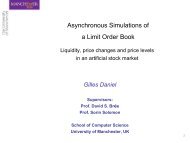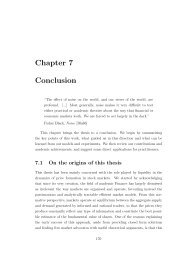market architecture of selected stock exchanges in ... - Gilles Daniel
market architecture of selected stock exchanges in ... - Gilles Daniel
market architecture of selected stock exchanges in ... - Gilles Daniel
You also want an ePaper? Increase the reach of your titles
YUMPU automatically turns print PDFs into web optimized ePapers that Google loves.
11 Introduction1.1 Motivation and Objective <strong>of</strong> the ThesisDur<strong>in</strong>g the last quarter century, exchange <strong>market</strong> and bank<strong>in</strong>g crises have newlyaroused <strong>in</strong>terest <strong>in</strong> the regulation and supervision <strong>of</strong> f<strong>in</strong>ancial <strong>market</strong>s. Given thattheir quality depends on rules determ<strong>in</strong><strong>in</strong>g the organization and regulation <strong>of</strong> thetrad<strong>in</strong>g process and the design <strong>of</strong> <strong>market</strong> structure, this has become subject to a newarea <strong>of</strong> research: the <strong>market</strong> microstructure theory.Market microstructure concentrates on the design <strong>of</strong> the <strong>market</strong>, on organizationaland regulatory features <strong>of</strong> the <strong>market</strong> sett<strong>in</strong>gs and their impact on the price discoveryprocess, liquidity, <strong>in</strong>formation asymmetry, and volatility. Furthermore, it analyzesparticipants and their ability to observe <strong>in</strong>formation and use for mak<strong>in</strong>g purchase andsale.The purpose <strong>of</strong> this paper, unlike <strong>market</strong> microstructure theory, is not to highlight theliquidity <strong>of</strong> an exchange and the use <strong>of</strong> <strong>in</strong>formation <strong>in</strong> the actual trad<strong>in</strong>g but ratherthe structural rules and their trad<strong>in</strong>g process on the <strong>stock</strong> exchange. However, s<strong>in</strong>cethe theory emphasizes those issues, too, this study <strong>in</strong>corporates some <strong>of</strong> its keyfactors. The so-called <strong>market</strong> <strong>architecture</strong> designates the full set <strong>of</strong> rules andregulations govern<strong>in</strong>g the <strong>exchanges</strong> and is <strong>of</strong> utmost importance to get a detailedcomparison <strong>of</strong> <strong>stock</strong> <strong>exchanges</strong>. To emphasize the significance <strong>of</strong> <strong>market</strong> regulation,Coase states that “free <strong>market</strong>s require considerable <strong>in</strong>ternal <strong>in</strong>frastructure and selfregulationto function efficiently with m<strong>in</strong>imal transaction costs” (Goodhart 1998,p.3). However, free f<strong>in</strong>ancial <strong>market</strong>s may not have the same level <strong>of</strong> regulation andthrough their macroeconomic environment they may also differ <strong>in</strong> depth, liquidityand volatility. This becomes obvious consider<strong>in</strong>g developed and emerg<strong>in</strong>g f<strong>in</strong>ancial<strong>market</strong>s.F<strong>in</strong>ancial <strong>market</strong>s <strong>in</strong> emerg<strong>in</strong>g countries are f<strong>in</strong>ancially weak <strong>in</strong> comparison with







